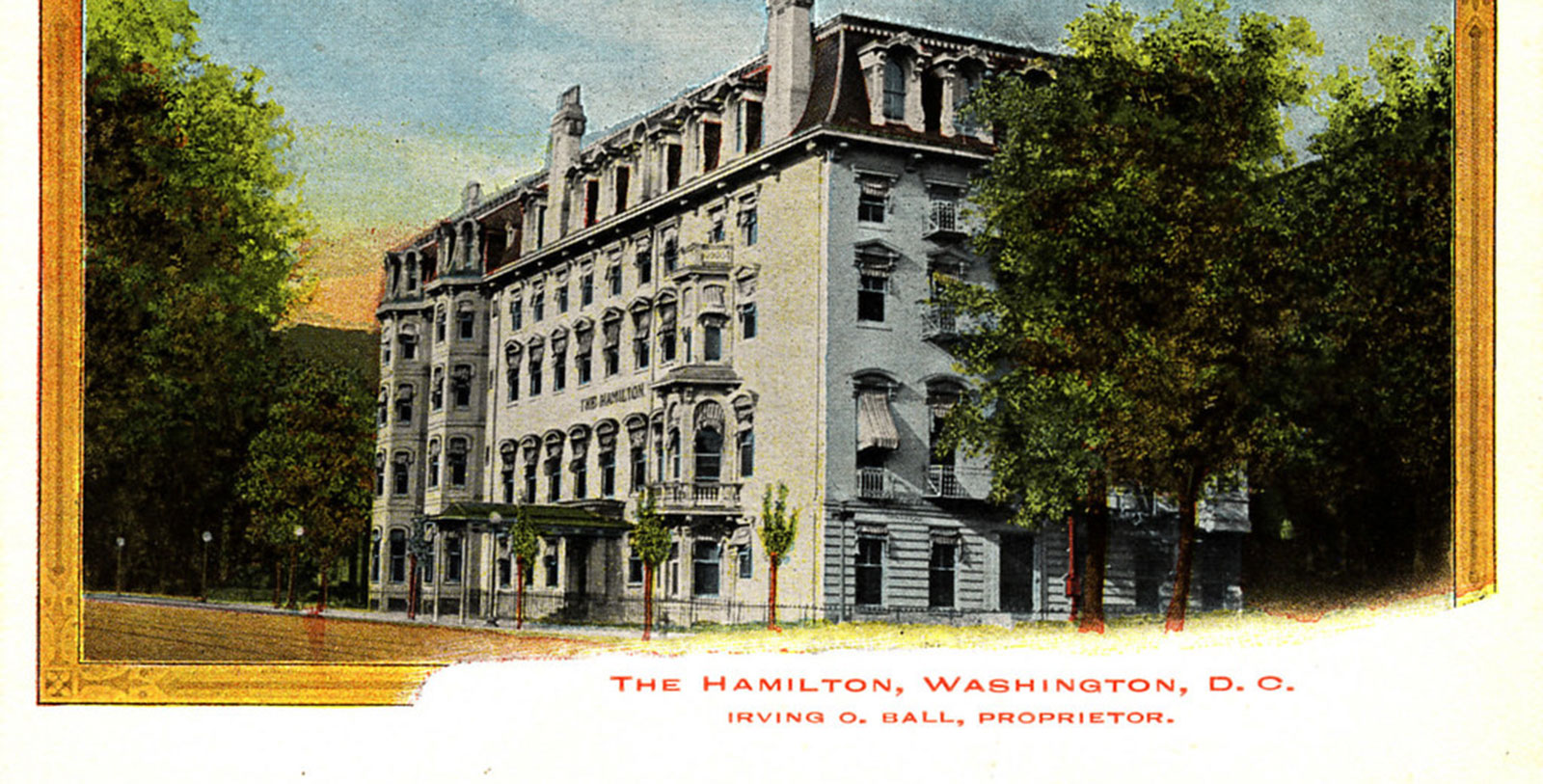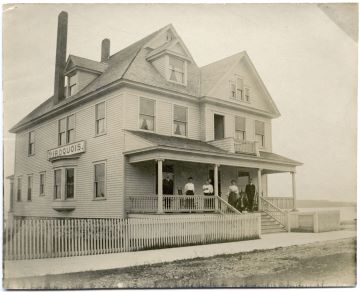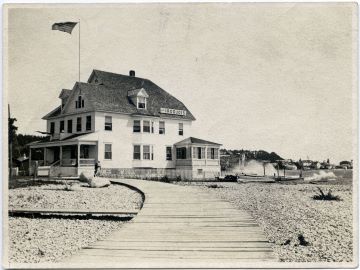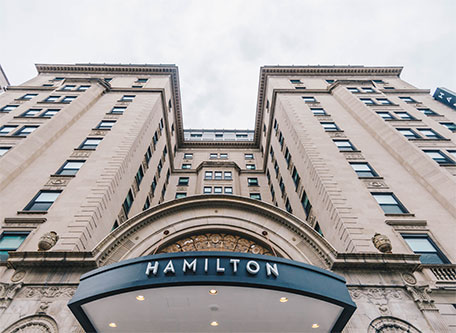Receive for Free - Discover & Explore eNewsletter monthly with advance notice of special offers, packages, and insider savings from 10% - 30% off Best Available Rates at selected hotels.
historic hotel in washington d.c.
Discover The Hamilton Hotel, which was once President Franklin Delano Roosevelt's "War Room" during World War II.
The Hamilton Hotel, a member of Historic Hotels of America since 2007, dates back to 1851.
VIEW TIMELINEListed on the U.S. National Register of Historic Places, the historic Hamilton Hotel has welcomed guests in downtown Washington, D.C. for generations. This beautiful building is actually the second iteration of The Hamilton Hotel as the original had opened in the middle of the 19th century. Situated across from Franklin Square, the first hotel initially opened as the “Rugby School”—a well-known boarding academy for adolescent boys. Then, in the 1860s, Admiral Horatio Bridge obtained the structure and converted it into a hostelry that he called “The Hamilton Hotel” in honor of Founding Father Alexander Hamilton. In just a matter of years, this fantastic hotel quickly became one of the most prevalent social gathering spots in the entire city. The height of its popularity transpired under the ownership of Irving O. Ball, who purchased the business on the eve of World War I. (A former general manager, Ball purchased the building for $125,000.) His stewardship elevated the prestige of The Hamilton Hotel significantly, as countless soirees and galas were hosted from within its spectacular meeting venues.
Unfortunately, its luster began to fade by the dawn of the Roaring Twenties, as more grandiose hotels opened throughout the surrounding neighborhoods. To revitalize its sagging prestige, the hotel’s ownership decided to thoroughly rebuild the building from the bottom up. Work on the edifice began under the watchful eye of Jules Henri de Sibour in 1921. An accomplished architect, Sibour had already designed several fantastic buildings across Washington, including The Investment Building, the McCormick Apartments, and the Clarence Moore House (today’s Embassy of Uzbekistan). Many of these structures are listed on the U.S. National Register of Historic Places, and the McCormick Apartments have been designated as a U.S. National Historic Landmark. He spent the next few months developing a brilliant 11-story hotel that featured some of the best Beaux-Arts-inspired architecture in the city. Among the most memorable aspects of the design included vaulted ceilings, refined wood moldings, and a stately entrance with an arched stained-glass window. Sibour even ensured that the décor was carefully hand-selected to complement the building’s unique architectural appearance.
When the new building finally opened a year later in 1922, The Hamilton Hotel immediately reestablished itself as one of Washington’s preeminent hotels. Needless to say, guests were incredibly awestruck by its unrivaled luxury. Each guestroom featured stunning views of the city and had access to then innovative technology such as in-room air-conditioning and telephone service. The hotel’s luxurious Rainbow Room emerged as a top culinary destination, too, with ownership importing its staff directly from The Plaza in New York City. The Hamilton Hotel enjoyed constant success, even as financial turmoil and global conflict afflicted the greater national economy. In fact, The Hamilton Hotel entertained some of the most illustrious people in the nation at the time. Hollywood’s singing cowboy Gene Autry and his horse, Champion, performed on occasion in the Rainbow Room, while former President Franklin Delano Roosevelt held one of his inaugural balls at the hotel, as well. (President Roosevelt also used the building as his “War Room” during World War II.) The Hamilton Hotel even acted as the temporary residence for William Green—one of the country’s greatest labor leaders—who often hosted dozens of union activists on the lower floors.
But as the surrounding area fell into decline, the hotel’s prosperity suffered consequently. In 1972, the building was eventually acquired by the Salvation Army, which used it as part of the “Evangeline Home for Girls” network of dormitories. The structure was then sold to a few real estate developers, who dreamed of revamping it into a mixed-used commercial complex. Thankfully, the building received a new lease on life two decades later when French hotel developer Albert Cohen purchased The Hamilton Hotel for a sum of $6 million. Before selling it a few years later, he completed a comprehensive renovation that restored the gorgeous hotel back to its former glory. Work on The Hamilton Hotel took three years to complete, as well as the work of dozens of craftsmen. The construction included an expansion with an additional two levels, increasing its size to over 300 guestrooms. Since reopening in 1996, The Hamilton Hotel has reemerged yet again as one of the best places to stay in all of Washington. A member of Historic Hotels of America since 2007, this magnificent historic hotel has a wonderful history and location worth experiencing.
-
About the Location +
The Hamilton Hotel is also just a few blocks away from the illustrious Lafayette Square Historic District. Anchored by the eponymous Lafayette Square, this famous neighborhood is home to such historical landmarks as the Blair House, the Decatur House, and the Eisenhower Executive Office Building. Lafayette Square is just a short walk from additional iconic locations, too, like the White House, The Ellipse, and the National Mall. In the words of the U.S. Department of the Interior: “Its statues remind visitors of the struggle to achieve a popular form of government, and it has often been a meeting place for those wishing to bring important issues to the immediate attention of the Chief Executive.” The destination first came into existence at the start of the 1800s, when laborers began developing the District of Columbia based on the plans of Pierre Charles L’Enfant. Originally destined to serve as an exclusive pleasure garden called “President’s Park,” Thomas Jefferson eventually authorized its construction as a public park to be enjoyed by everyone. But construction did not fully commence until after the Marquis de Lafayette’s visit in 1824. (American politicians later named the area after the French diplomat, settling on the title “Lafayette Square.”) But the first actual landscaping took place some three decades later, when prominent architect Andrew Jackson Downing sculpted the nucleus of its current appearance. Amazingly, Downing’s layout has remained mostly the same, with just minor alterations transpiring in the 1870s, 1930s, and 1960s. Lafayette Square today is among the city’s most noteworthy destinations, as it hosts thousands of visitors from all over the world every year.
Another famous historical area close to the hotel is the Fifteenth Street Financial Historic District, which was once the financial heart of Washington throughout the 19th and early 20th centuries. In fact, many of the buildings that originally resided in the area were banks, with some of the earliest founded in the 1820s and 1830s. The greatest of those banks to ever open was a branch of the Second Bank of the United States, inhabiting a structure at the juncture of 15th Street and Pennsylvania Avenue before its closure by President Andrew Jackson in 1836. The firm Corcoran and Riggs occupied the building thereafter and reorganized as the famous Riggs National Bank several decades later. It subsequently constructed a new bank headquarters further up the road in 1898, outfitting it with the finest Classical Revival-style architecture. Other prominent banks opened for business at the height of the Gilded Age, including the National Metropolitan Bank, the First American Bank, American Security Bank, and the National Savings and Trust Company. But most of the financial institutions that had begun operating in the neighborhood were community oriented, since the region’s lack of commercial trade connections had deterred national investment. Nevertheless, those financial institutions spurred Washington’s growth for years, helping it morph into the sprawling international city it is today. They also developed many magnificent structures that showcased some of the best architecture in the whole city. Some of the best architectural minds in the nation worked on the new structures, too, including the likes of Daniel H. Burnham, J.H. de Sibour, John Merven Carrère, and Thomas Hastings. All students of the celebrated École des Beaux-Arts in Paris, they proceeded to erect a number of outstanding skyscrapers created with a combination of Classical Revival and Beaux-Arts-themed architecture.
-
About the Architecture +
Although plans to redevelop the Hamilton Hotel had been planned since the early 20th century, its current appearance did not debut until the start of the 1920s. Owner Felix Lake specifically hoped to revitalize interest with the aging building and hired a celebrated architect named Jules Henri de Sibour to supervise the project. An accomplished architect, Sibour had already designed several fantastic buildings across Washington, including The Investment Building, the McCormick Apartments, and the Clarence Moore House (today’s Embassy of Uzbekistan). In fact, many of these structures are listed on the U.S. National Register of Historic Places and the McCormick Apartments are even identified as a U.S. National Historic Landmark. Nevertheless, Sibour started constructing the new Hamilton Hotel on Lake’s behalf in 1921. Taking several months to complete, Sibour managed to create a brilliant 11-story hotel that featured a wonderful façade made of gorgeous Indiana limestone. Among the most memorable aspects of the design included vaulted ceilings, refined wood moldings, and a stately entrance with an arched stained-glass window. Sibour even ensured that the décor was carefully hand-selected to complement the building’s unique architectural aesthetics. A few local newspapers even commented on the selection of furniture, stating that it took Sibur months just to finalize what he intended to purchase.
Hamilton Hotel itself displays a wonderful blend of Beaux-Arts style architecture, which became widely popular around the dawn of the 20th century. This beautiful architectural form originally began at an art school in Paris known as the École des Beaux-Arts during the 1830s. There was much resistance to the Neoclassism of the day among French artists, who yearned for the intellectual freedom to pursue less rigid design aesthetics. Four instructors in particular were responsible for establishing the movement: Joseph-Louis Duc, Félix Duban, Henri Labrouste, and Léon Vaudoyer. The training that these instructors created involved fusing architectural elements from several earlier styles, including Imperial Roman, Italian Renaissance, ad Baroque. As such, a typical building created with Beaux-Arts-inspired designs would feature a rusticated first story, followed by several more simplistic ones. A flat roof would then top the structure. Symmetry became the defining character, with every building’s layout featuring such elements as balustrades, pilasters, and cartouches. Sculptures and other carvings were commonplace throughout the design, too. Beaux-Arts only found a receptive audience in France and the United States though, as most other Western architects at the time gravitated toward British design principles.
-
Famous Historic Guests +
Gene Autry, actor known for such roles in The Phantom Empire, In Old Santa Fe, and The Old Corral.
William Green, President of the American Federation of Labor (1924 – 1952)
Franklin Delano Roosevelt, 32nd President of the United States (1933 – 1945)
Harry S. Truman, 33rd President of the United States (1945 – 1953)



































